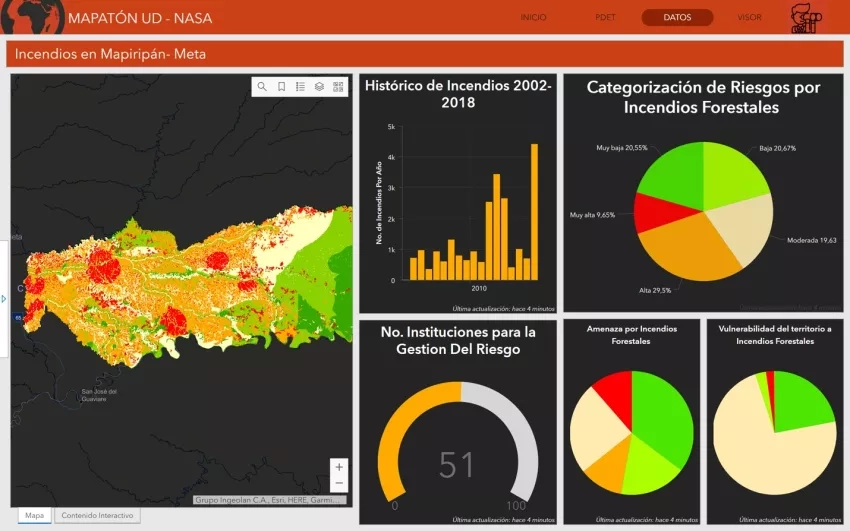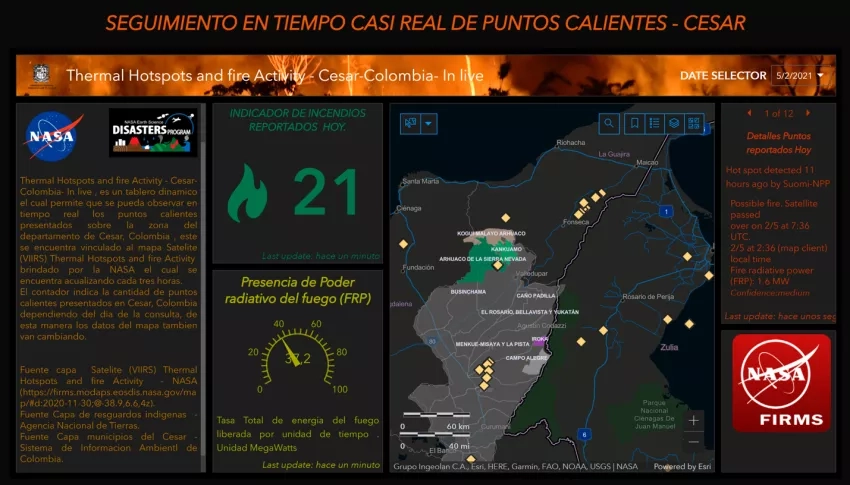Lea esta historia en español aquí.
The District University of Bogotá, Colombia – NASA Mapathon
This past winter, the District University of Bogotá teamed up with NASA’s Disasters Program to host an interagency mapathon. During the event, 45 students from the University used open data from remote sensing satellite instruments to create maps and models that depict natural hazard patterns. NASA scientists provided helpful advice to the students throughout the activity. The purpose of the mapathon was to use NASA data to generate products that can inform local decision-making in land use planning and disaster risk reduction, ultimately helping Colombia build a more resilient and sustainable future for its people.
The Mapathon Process
Before the mapathon began, guest speakers from various research organizations, including NASA’s Applied Sciences Disasters Program, sought to inspire and educate students through a series of thematic talks on topics such as forest fires, the NASA Disasters Mapping Portal, and even drones! These webinars provided the students with the background information necessary to understand threat identification and risk management in Colombia’s most vulnerable municipalities. Next, experts in geographic information and modeling worked closely with students to train them in data usage, Geographic Information Systems (GIS) and risk management strategies. After their training, the students branched off into nine interdisciplinary teams and worked together to create a prototype for one specific topic within risk management. Each team had only six days to develop a proposal for their prototype, consulting professionals in the field when necessary. When those six days were up, each team had 10 minutes to present their proposal to the jury and five minutes to answer the jurors’ questions. The concepts were so impressive that the jury was obliged to select two first-place winners instead of just one.
Final Products to Support Decision-Making in Local Communities
Overall, the teams created nine outstanding final products – each one evaluated for its innovation, applicability, scalability, and replicability. In first place is the prototype for Community Response Strategies in Mercaderes, Cauca. Developed by Alejandro Castellanos C., Aura I. Tovar L., Laura K. Bernal R., Brayan A. Cardozo S., and Duvan F. Rodríguez B., this susceptibility model allows the viewer to predict which communities are most susceptible to mass movements within the municipality of Mercaderes, Cauca.
Sharing the top spot is the prototype for Early Fire Alerts Systems in Valledupar, Cesar. This prototype, developed by Karen L. Cáceres O., Karen V. Forero L., Luisa F. Vaquiro D., Nicolas S. Alvarado R., and Eric L. Perico C., seeks to ensure a quicker and more effective response to wildfires within the local community of Valledupar, Cesar.
Seven other teams also produced outstanding risk management prototypes. A team consisting of Karen V. Gutiérrez P., Tatiana Torres T., Santiago A. Orjuela O., Luis M. Guerrero B., and Yeiferson L. Romero B. produced the prototype for Climate Change Scenarios in Necoclí, Antioquia, which provides decision-makers with a replicable tool for examining current and future climate projections.
Next, there is the prototype for the Early Warning System for Change of Coverage in Villagarzón, Putumayo. Developed by Wendy A. Matallana L., Paula N. Becerra Q., and Jorge L. Mora A., this product allows the viewer to visualize changes in land use over time and look at future projections for land use in the face of climate change.
Wendy K. Lorenzana V., Sebastián Murcia B., Jhon E. Sánchez H., Yenny A. Pineda G., and Adalina Rivera G. produced the Valdivia Antioquia Emergency Plan prototype, which condenses damage information to allow the viewer to identify areas of the population in need of emergency assistance.
The next team, consisting of Andrés S. Avendaño G., Karen Zambrano V., Leidy D. García G., Danyela E. Muñoz M., and Ángel D. Mendoza S., produced the Automation for Fire Analysis in Mapiripán, Meta prototype. This model enables the user to conduct spatial analyses on forest fire risk management within Mapiripán, Meta.
María F. Ardila M., Leissy A. Sánchez R., Harold A. León V., and Jhon S. Urintive put together the Collaborative Risk Management Systems in Tame, Arauca prototype, which combines a flood susceptibility model and a map of flood-safe areas within the municipality to reduce flood risk.
The next team produced the Resilient Infrastructure in Olaya Herrera, Nariño prototype. This interface, created by Juan S. Hernández S., Natalia Herrera Q., Linda Y. Benavides L., and Julian D. Rodríguez N., aims to provide the foundation for efficient and rapid recovery plans Olaya Herrera, Nariño.
Rounding up the outstanding entries, David S. Hernández M., Norida M. Bustos L., Santiago Blanco P., Tania Valencia Z., and María A. Bermudez A. developed the Restoring Ecosystems as a Measure for the Mitigation of Flood Risks in the Municipality of Fundación, Magdalena prototype, which uses mapping software to create an interactive depiction of land susceptibility for flood risk and ecosystem restoration.
Purpose of the Prototypes
The 45 talented students involved in the mapathon combined their interdisciplinary experiences to create this innovative suite of prototypes for disaster risk management in Colombia. Each of the nine prototypes is targeted toward the municipalities prioritized in the Territorially Focused Development Plans (PDET) for Colombia and will be used to benefit the people living in the country’s most vulnerable areas. The DU-NASA Mapathon serves as an example of how academic institutions can play a prominent role in connecting NASA data with local communities. The prototypes aim to improve disaster preparedness, and with improved disaster preparedness comes a reduced loss of life and a quicker recovery from hazards. For the people of Colombia, the mapathon’s success means an opportunity to grow their economy and improve their living standards – with lower chances of having to start all over again. In the future, NASA will be partaking in even more mapathons – such as the ongoing AmeriGEO-Peru Mapathon with over 600 participants and judges from 17 countries, or the Innovation Challenges, coming up in September, where universities involved in the Central American Integration System (SICA) will share science, expertise, and geospatial data for disaster risk reduction – to further its mission to bring reliable disasters data to Latin America.





